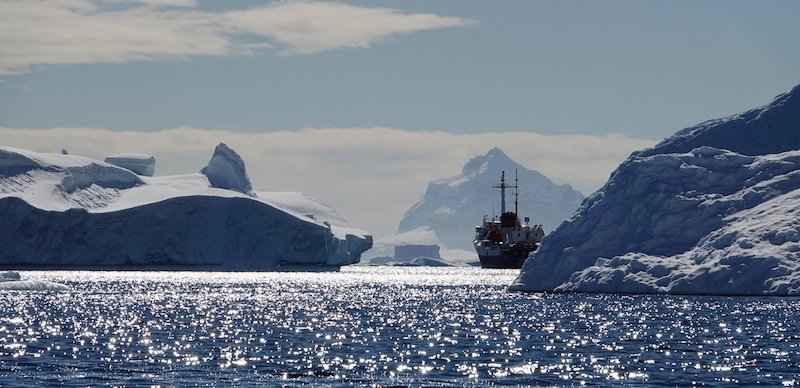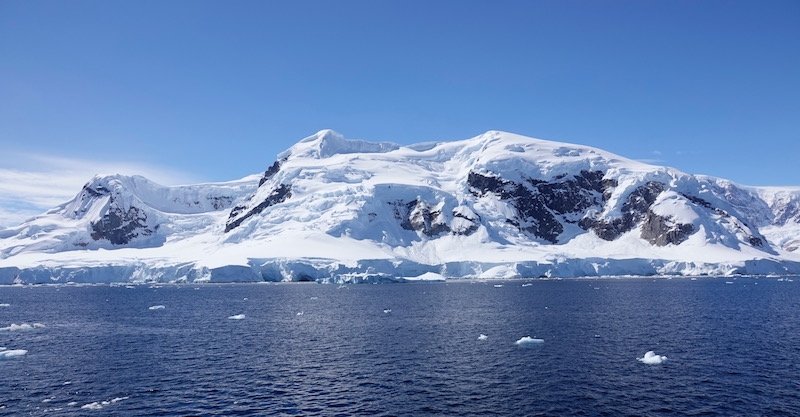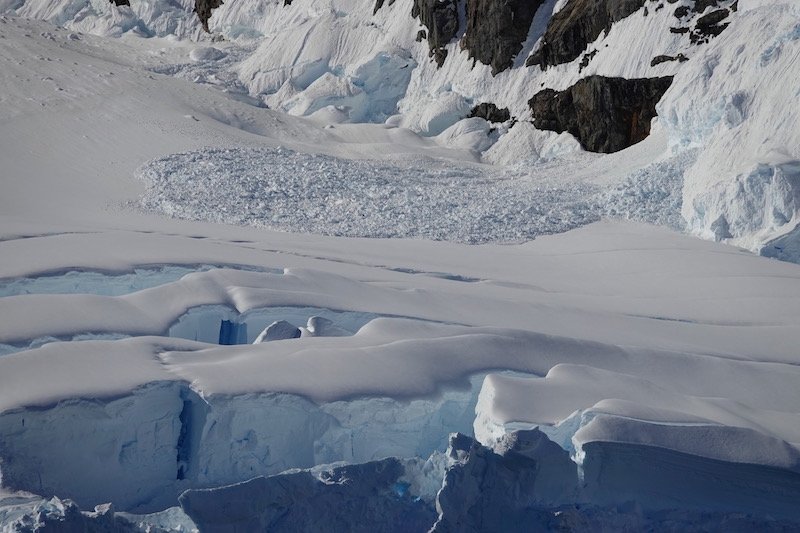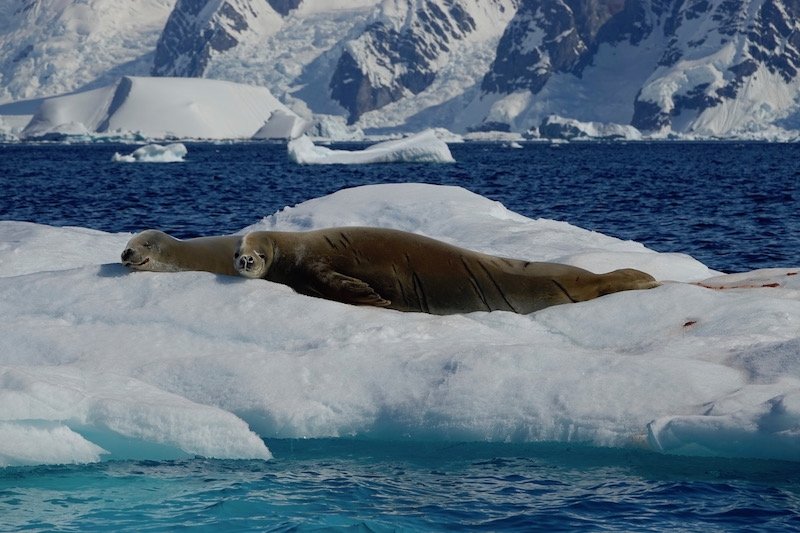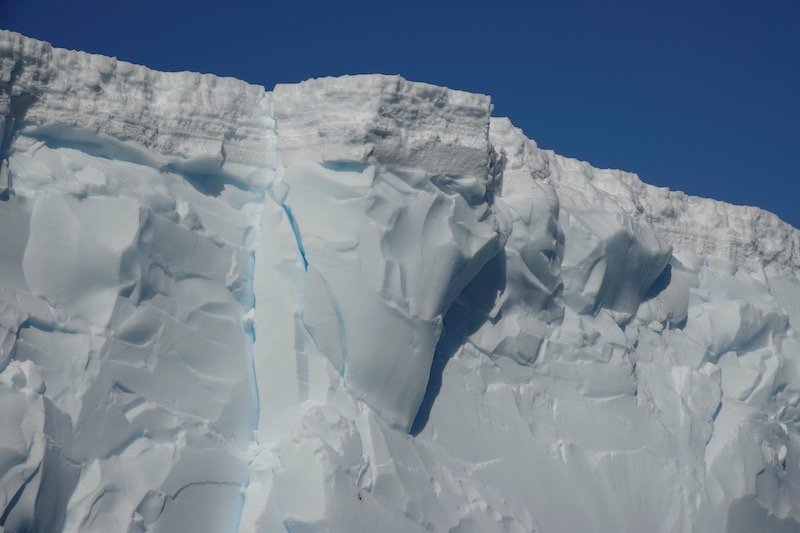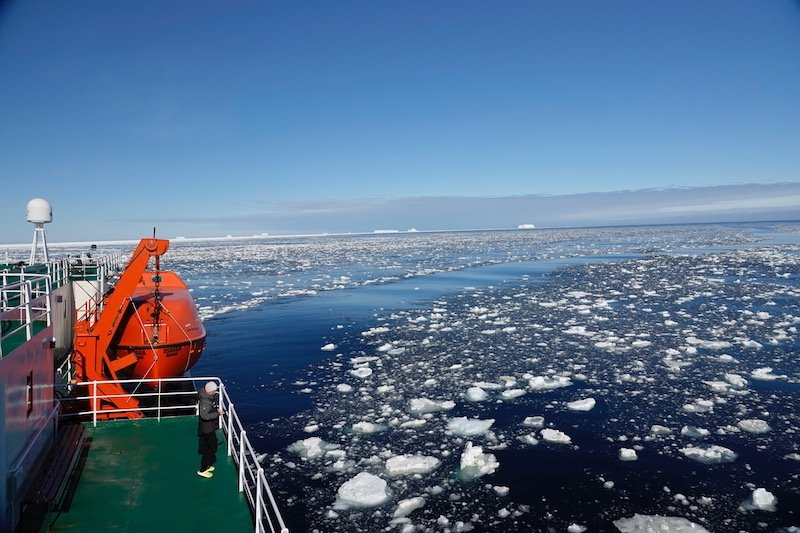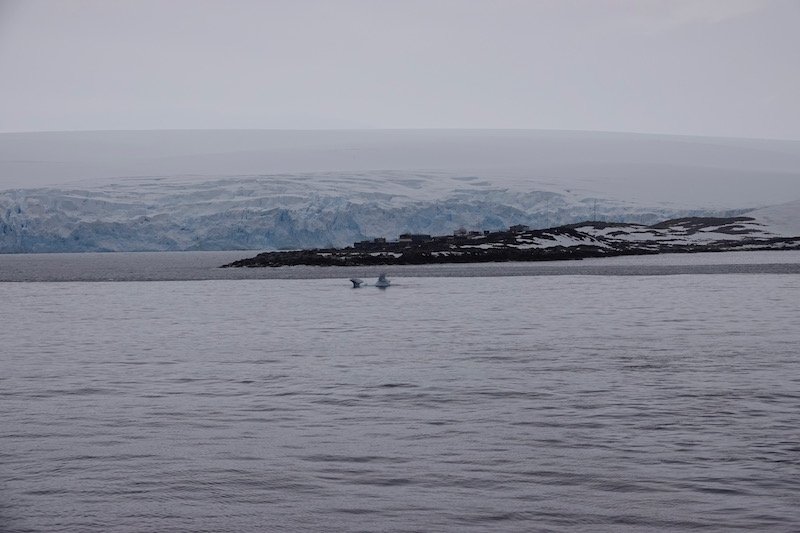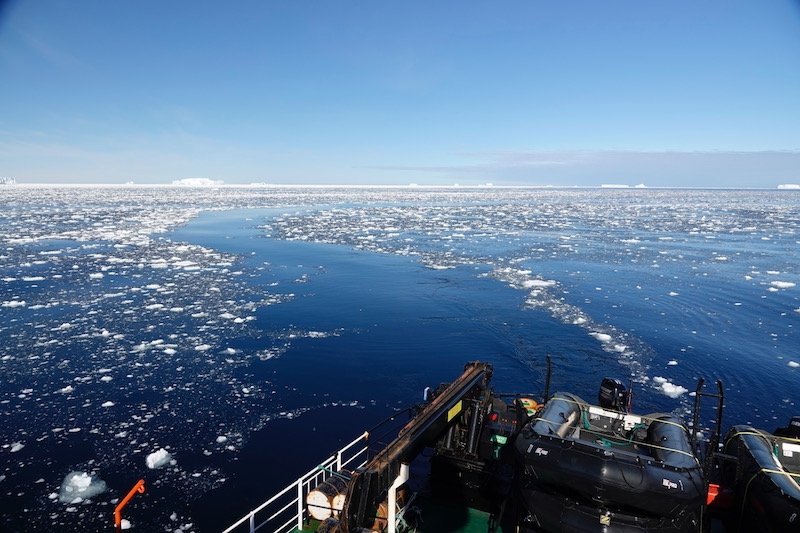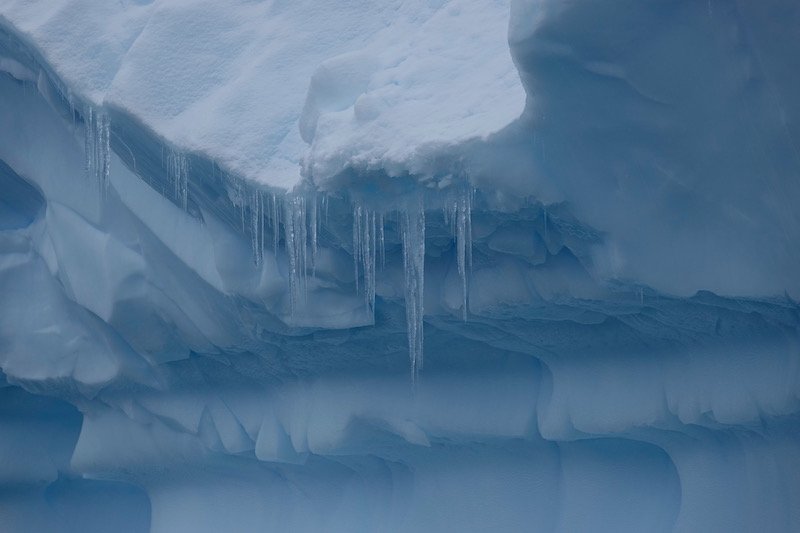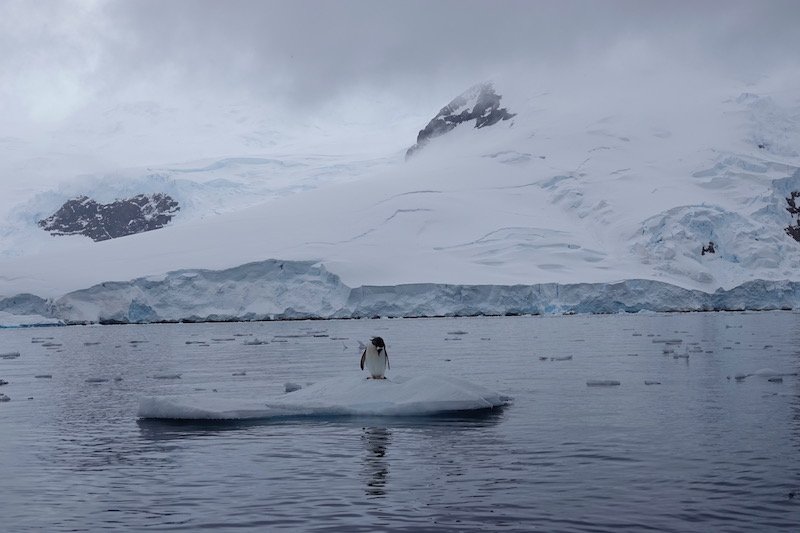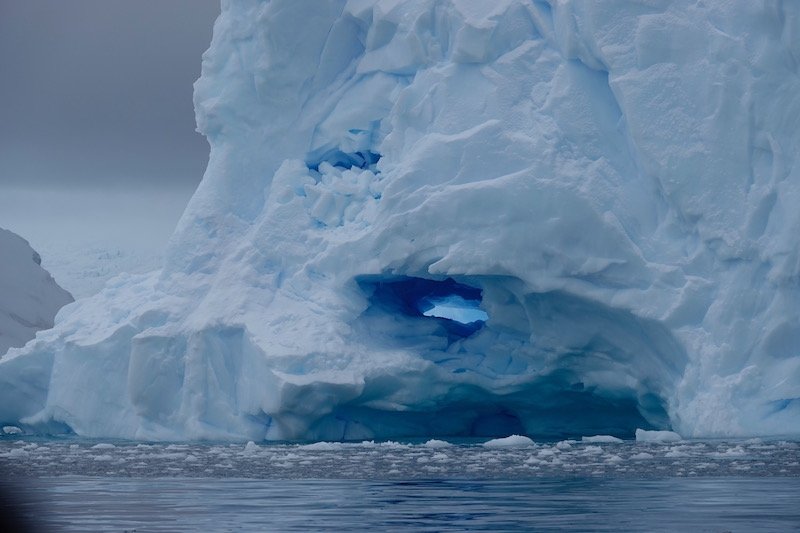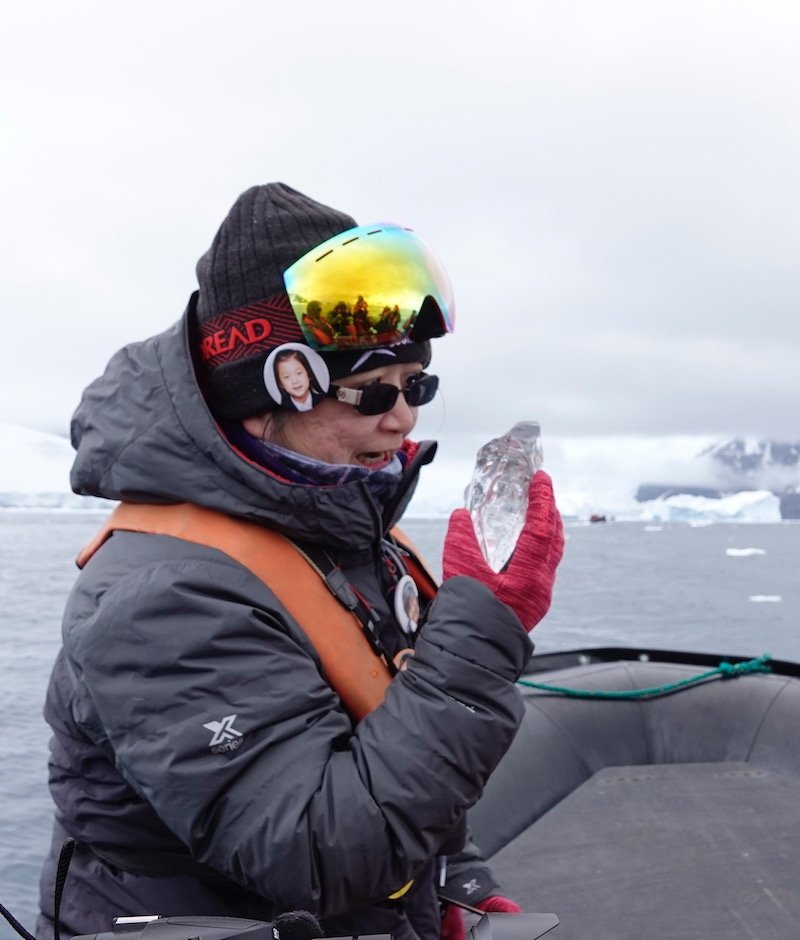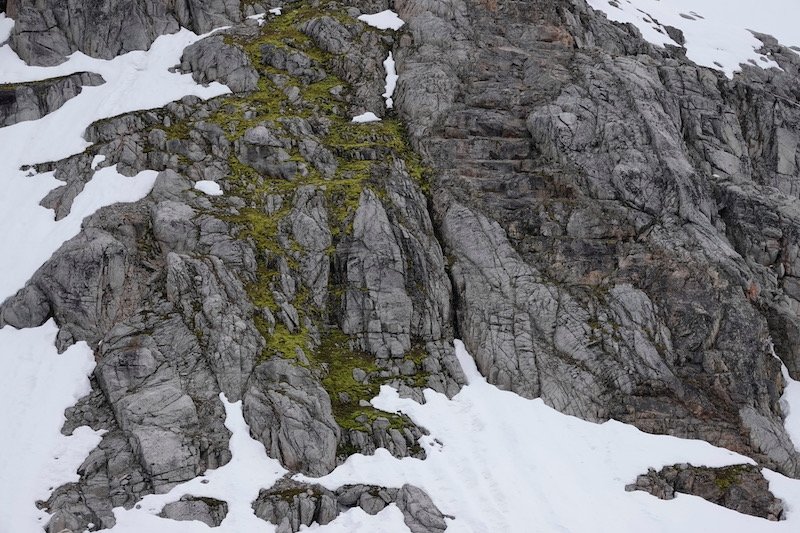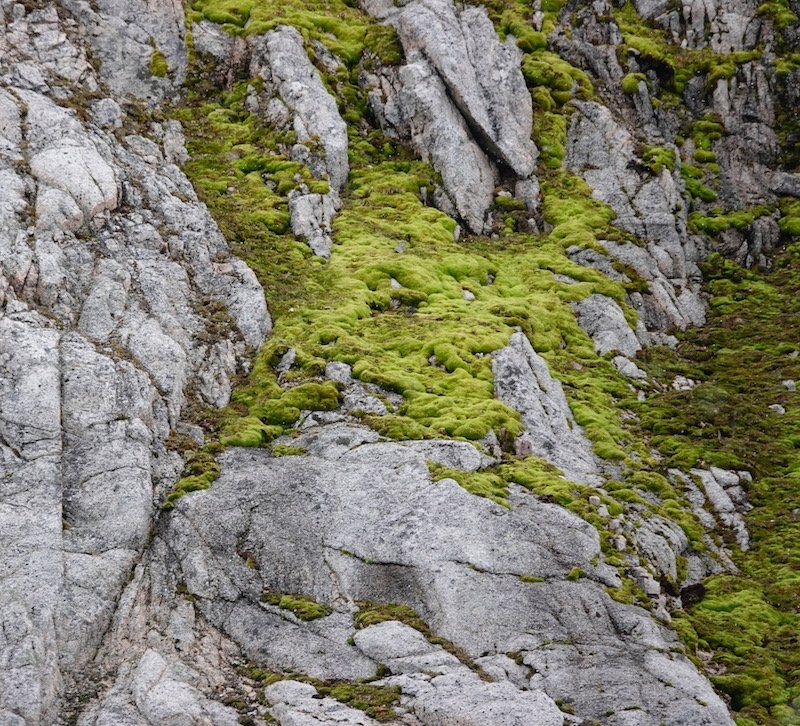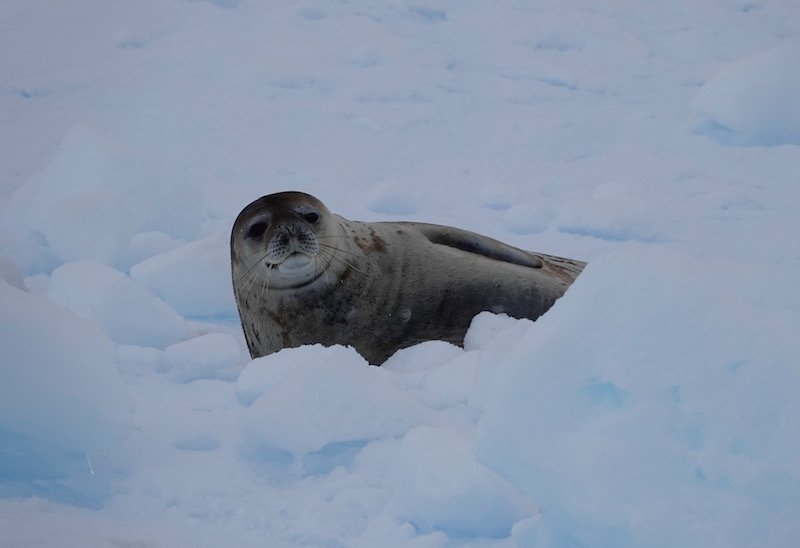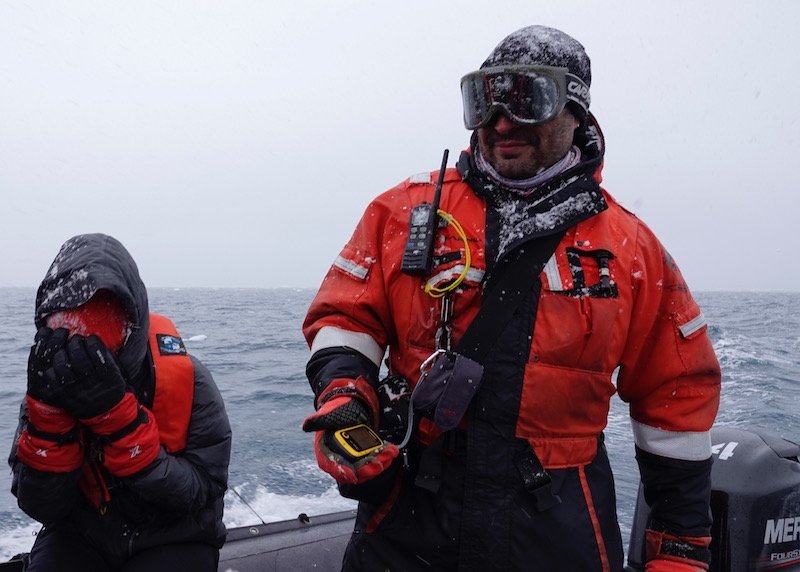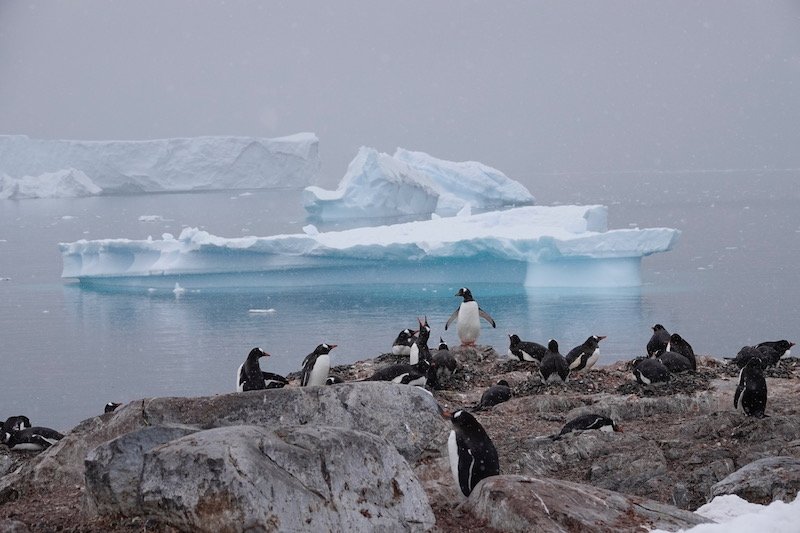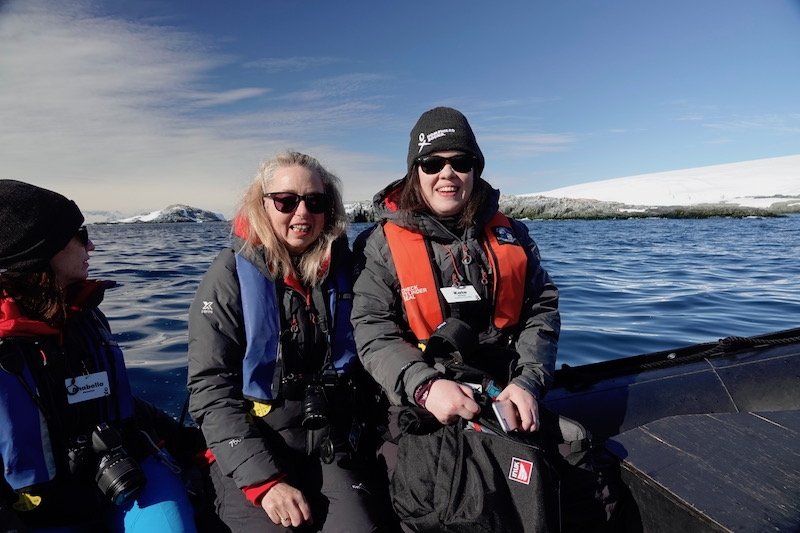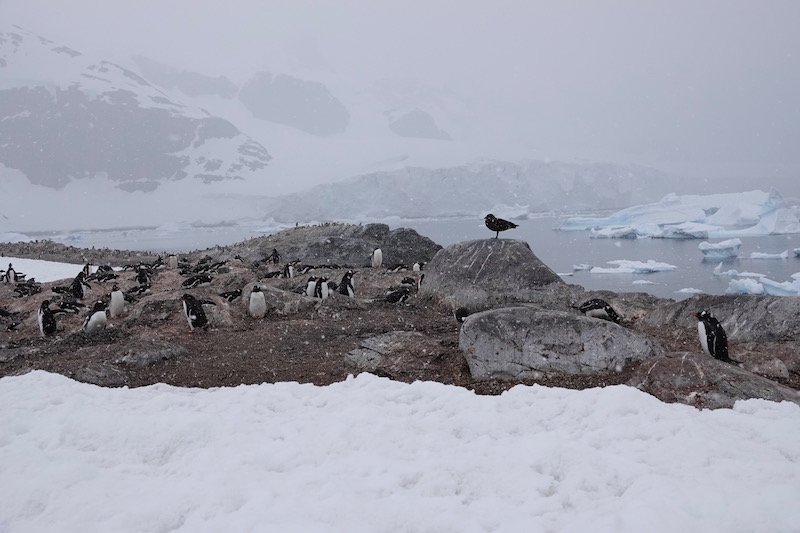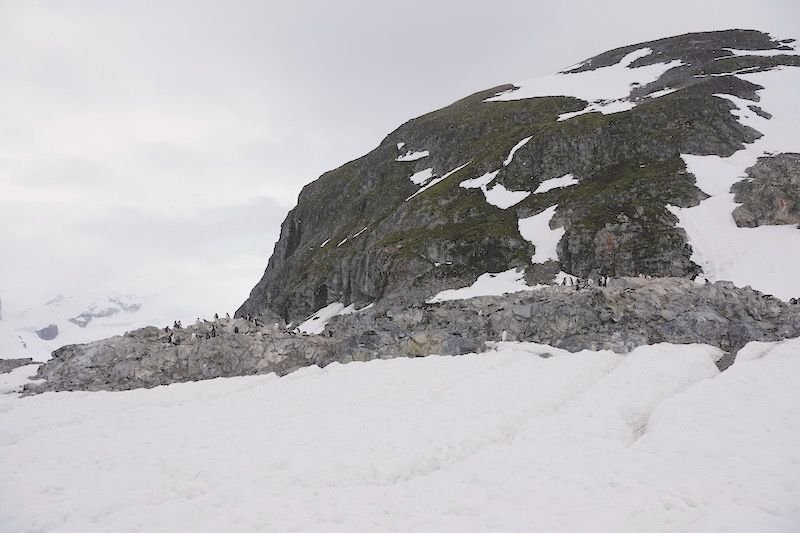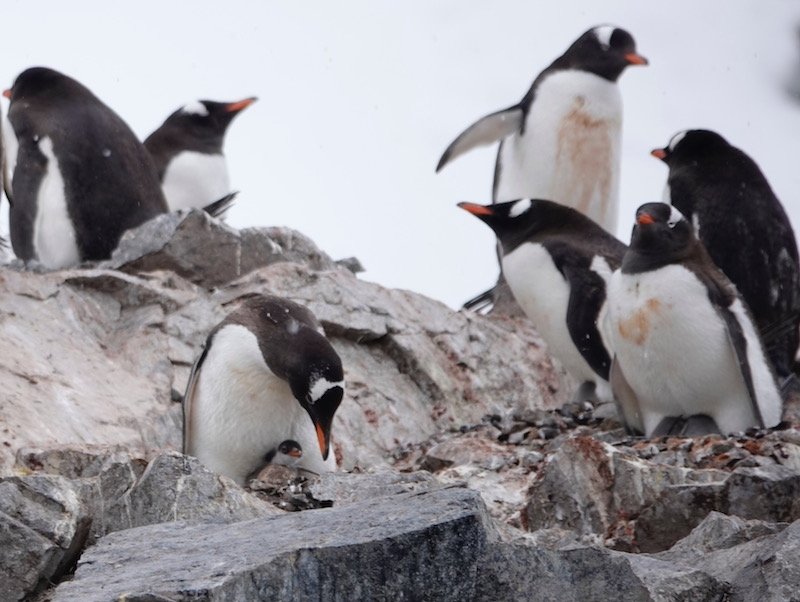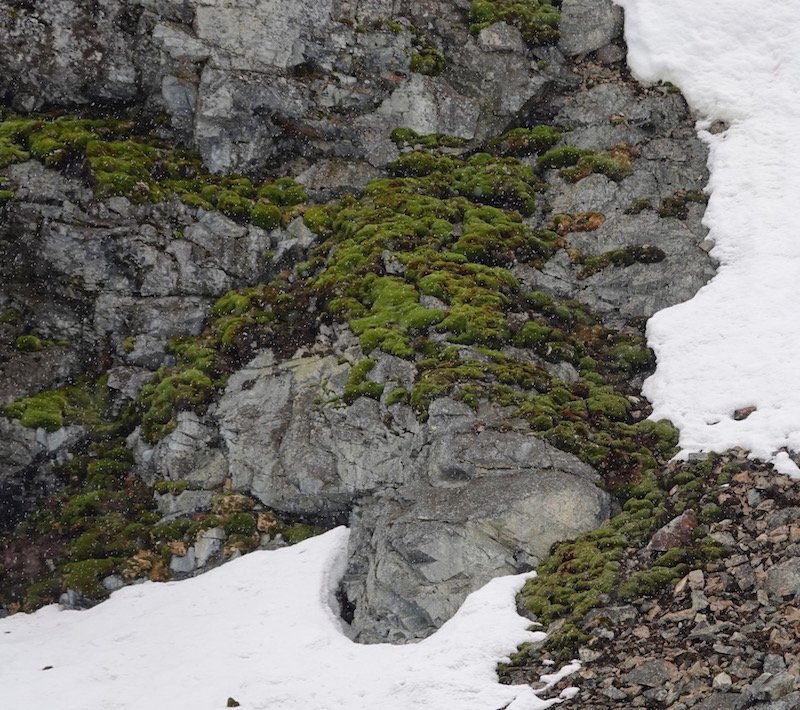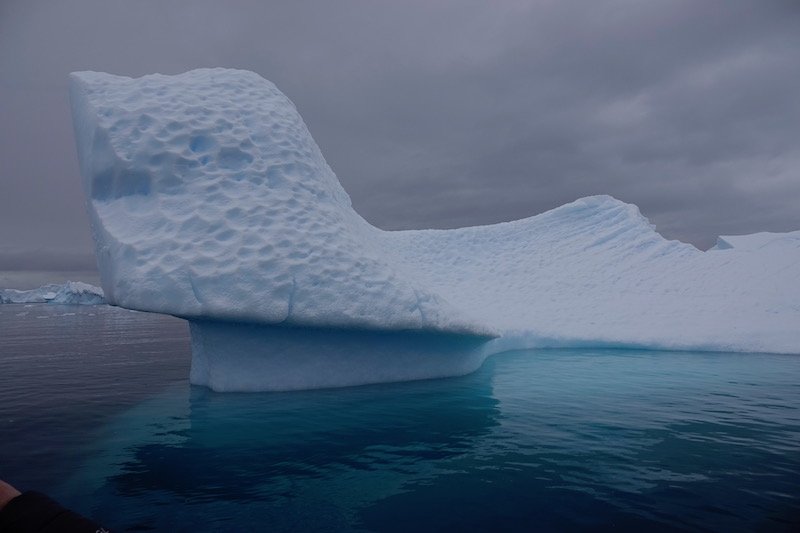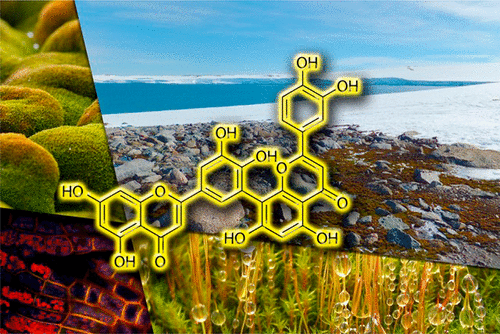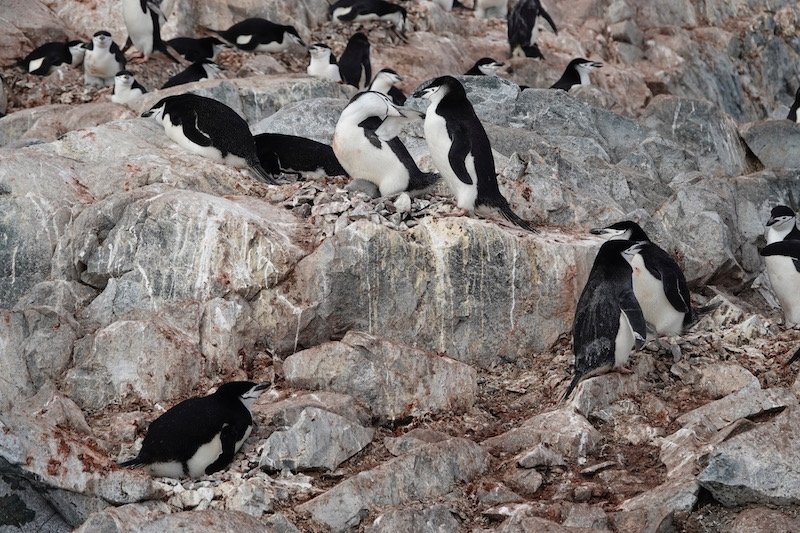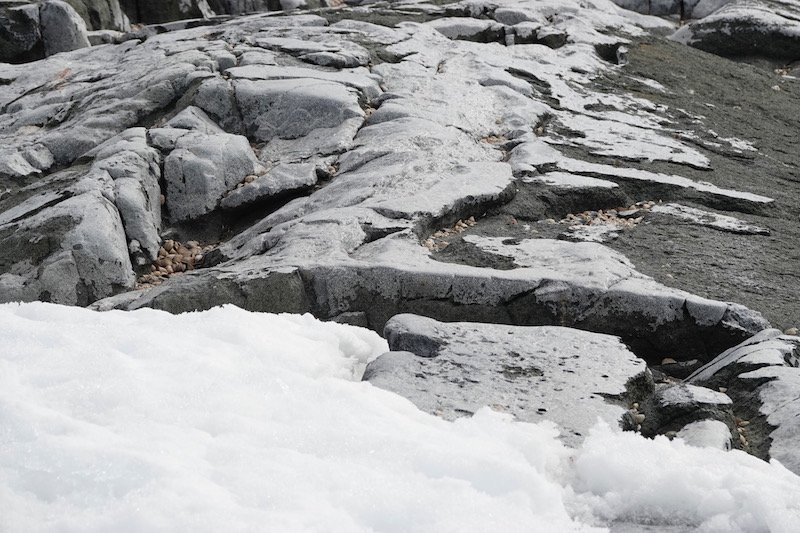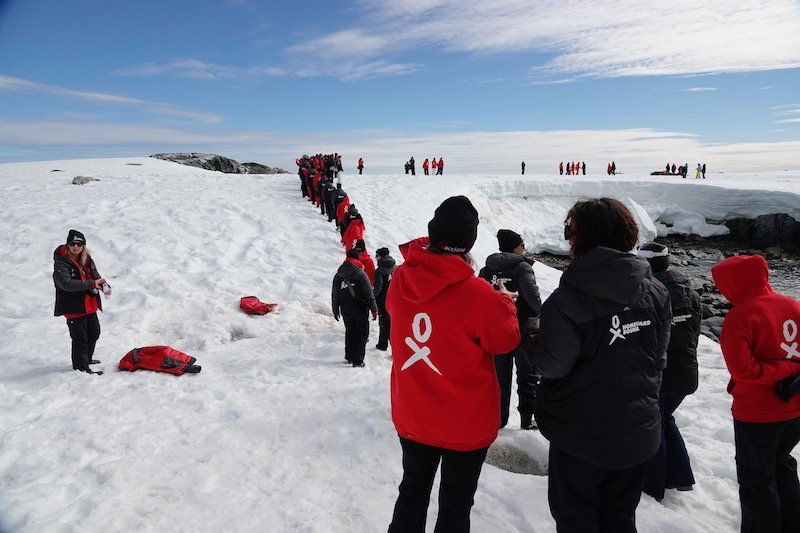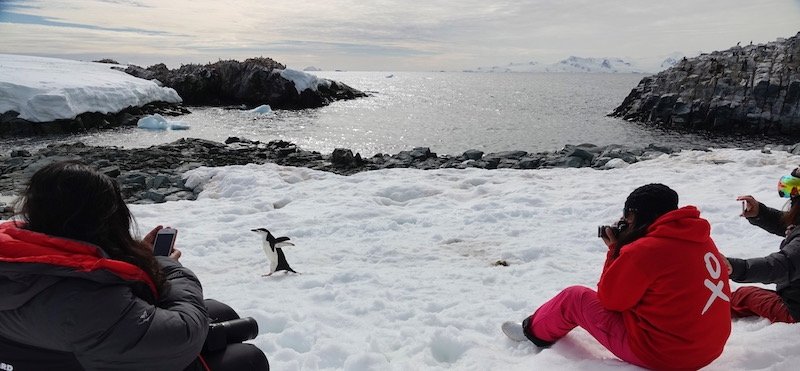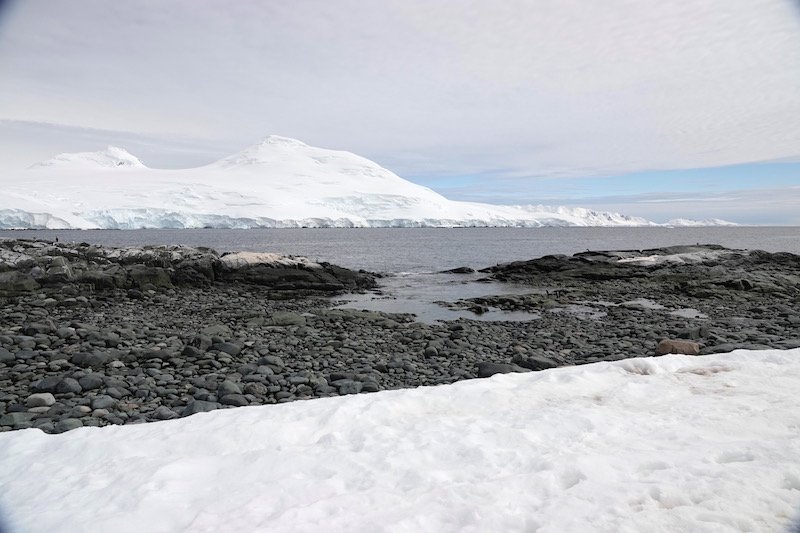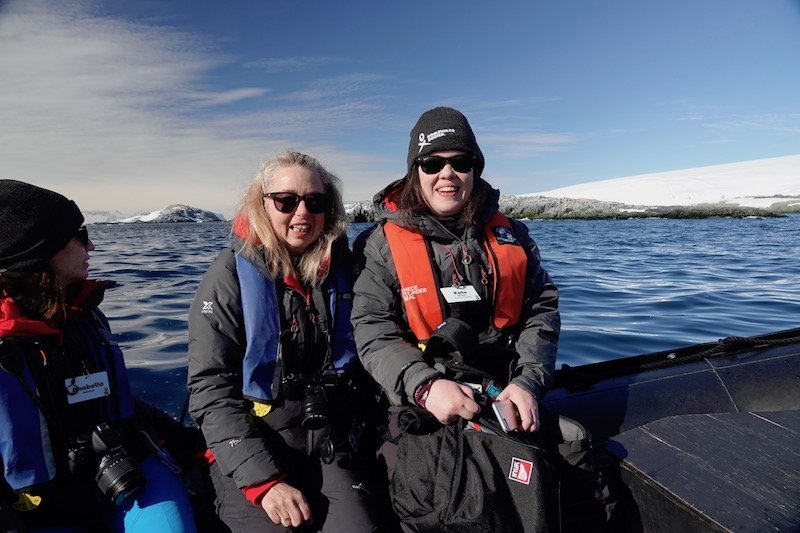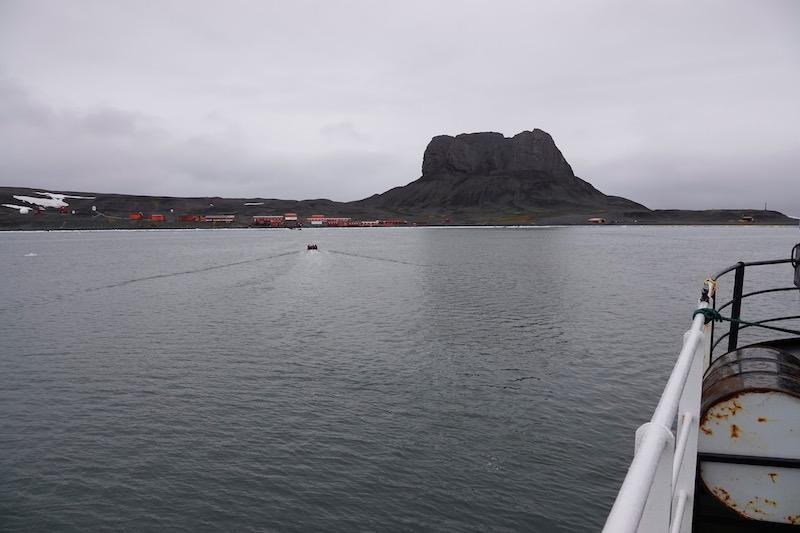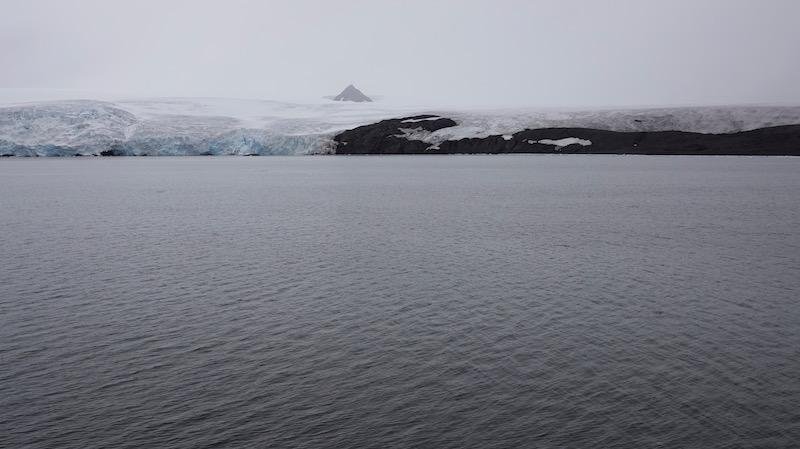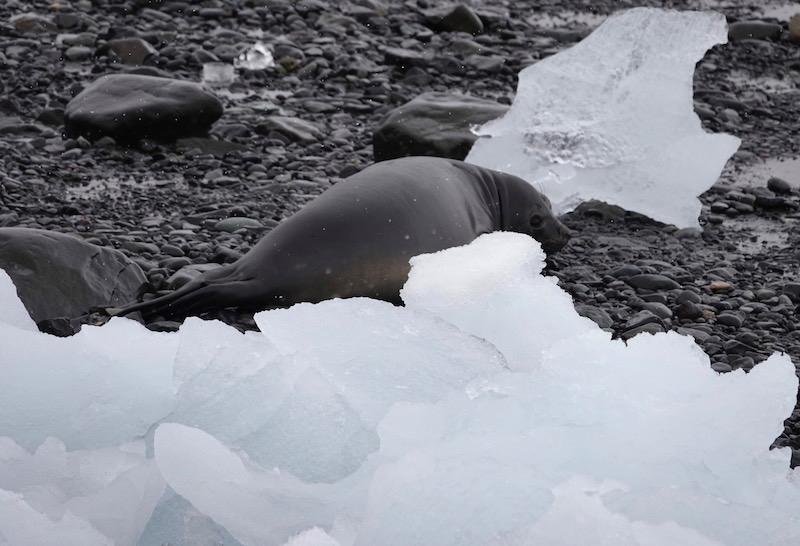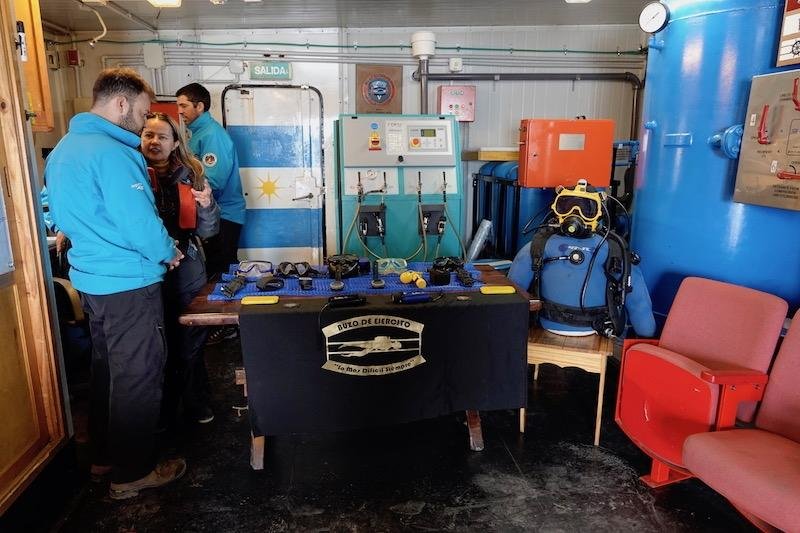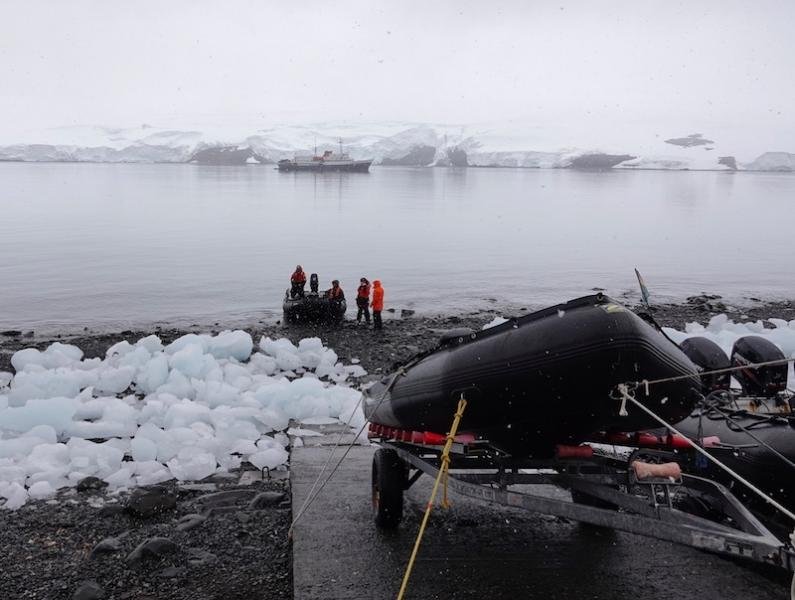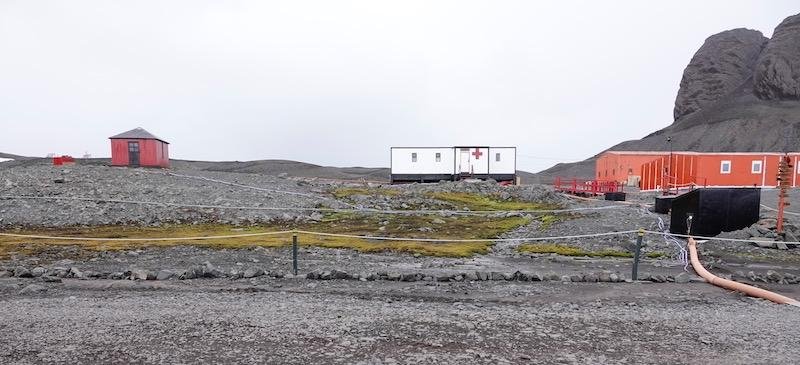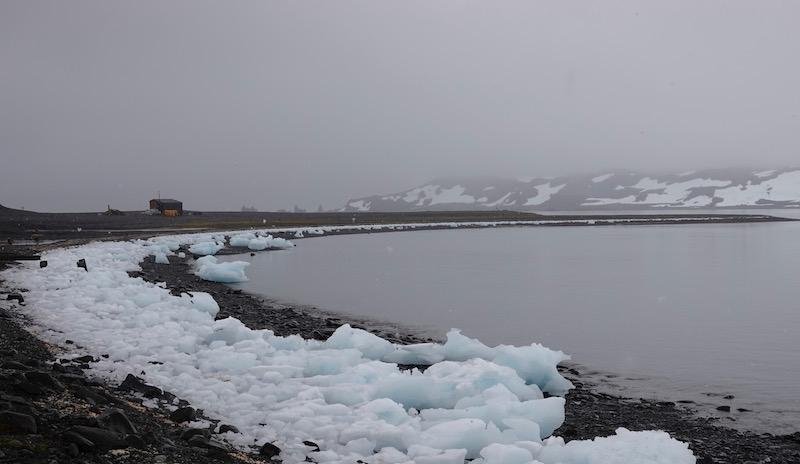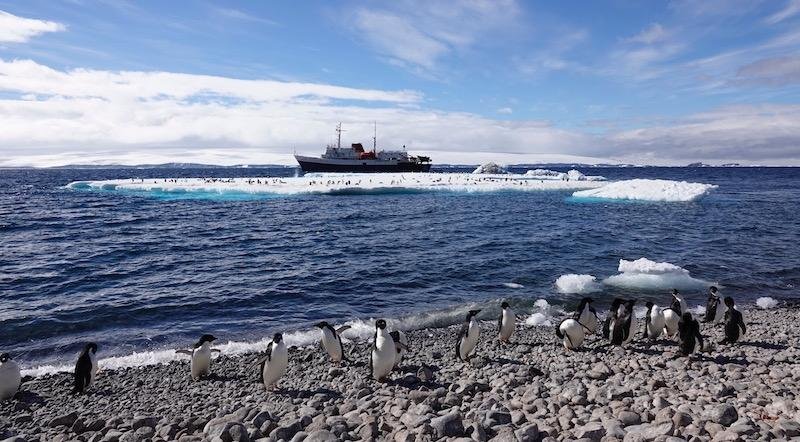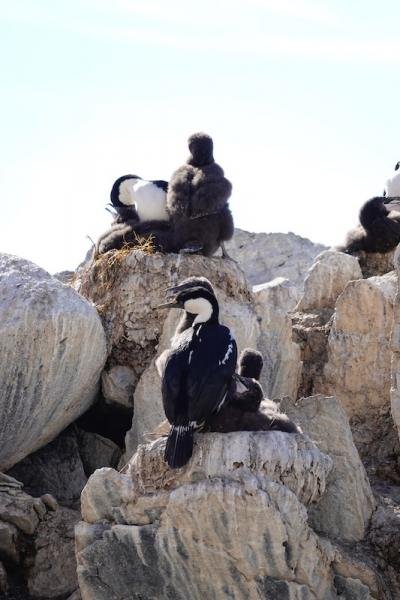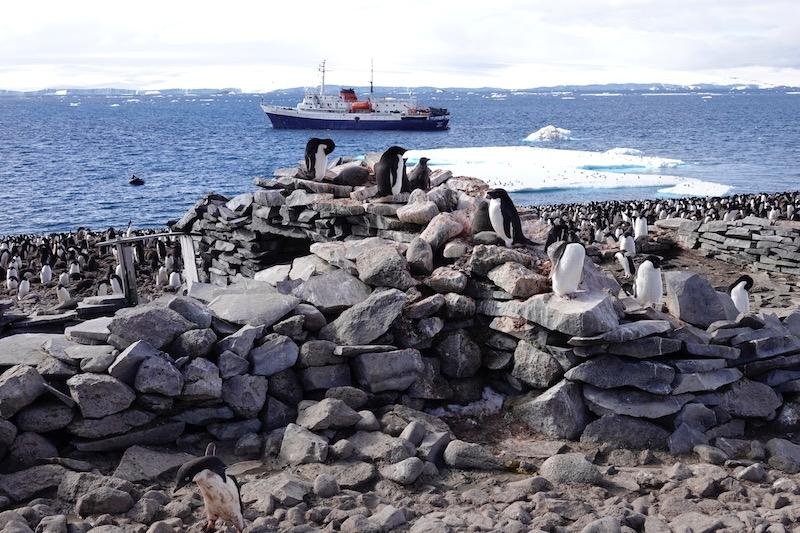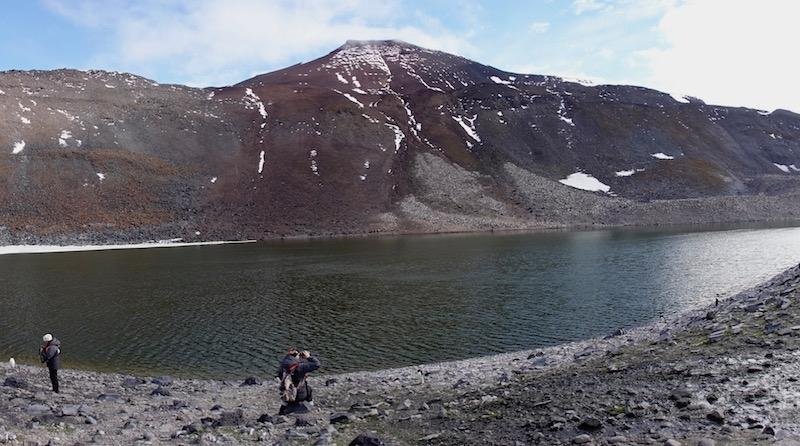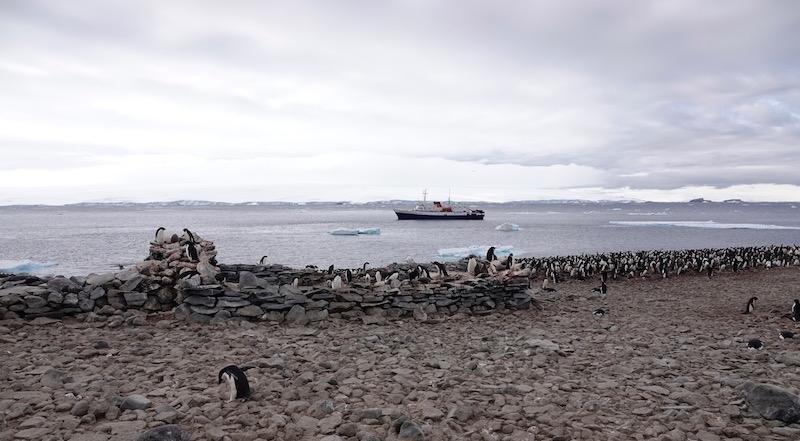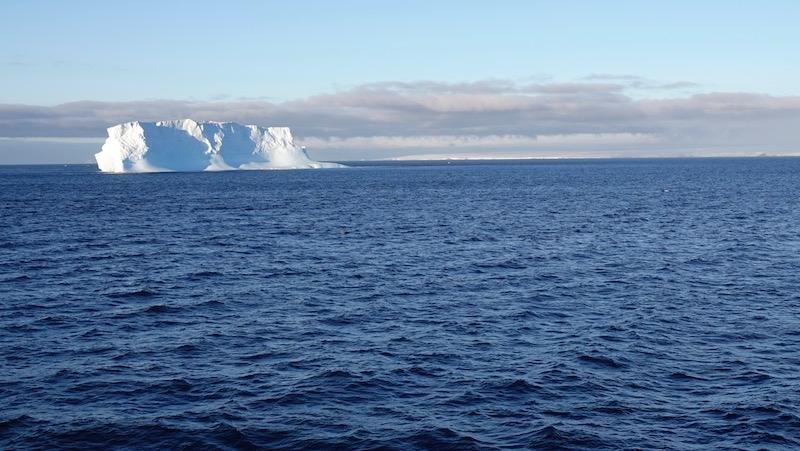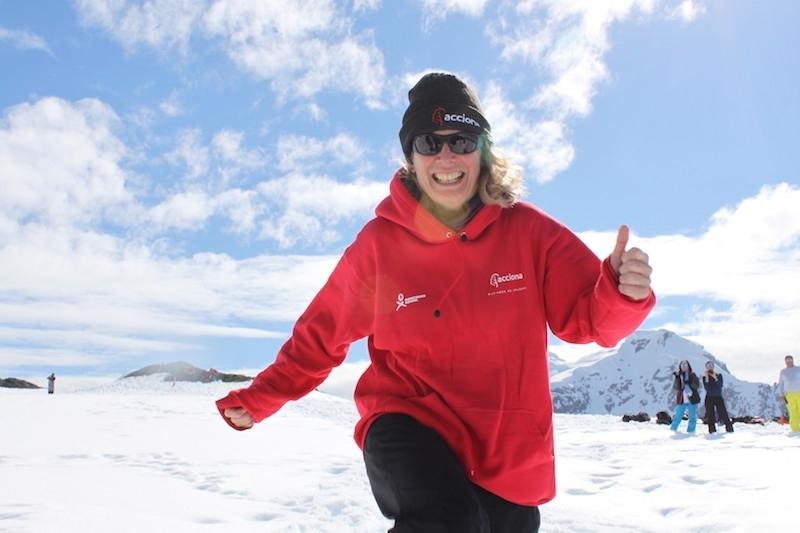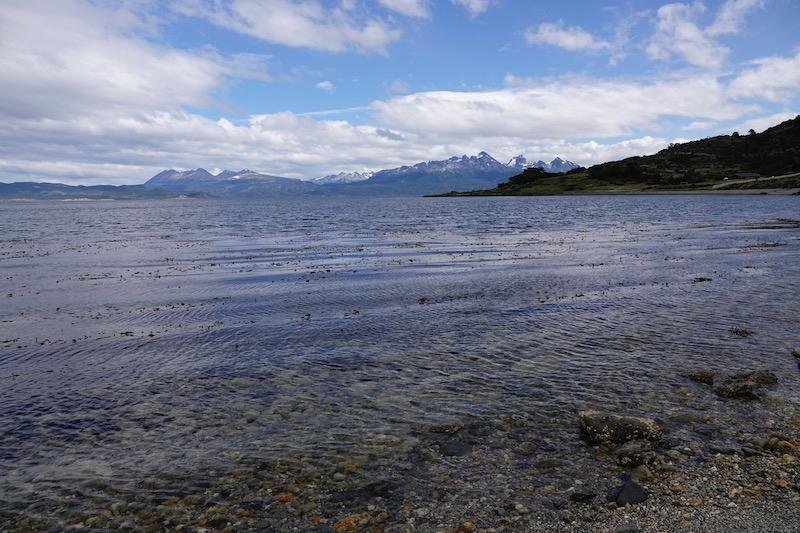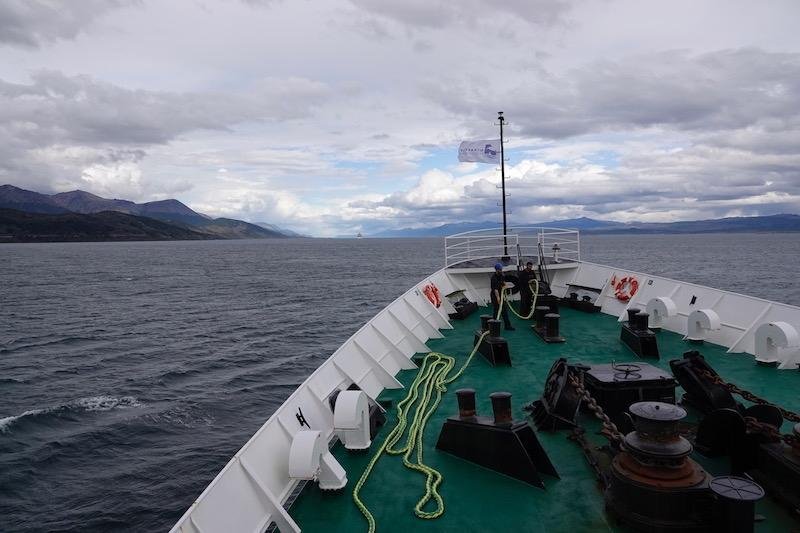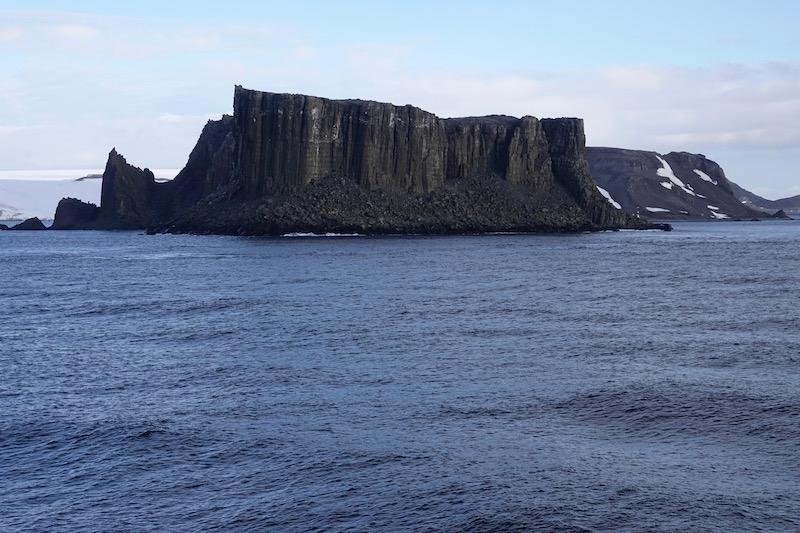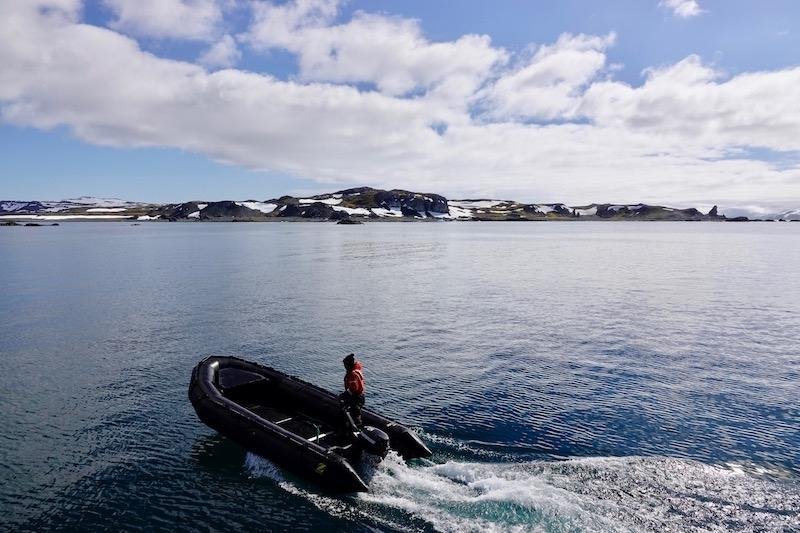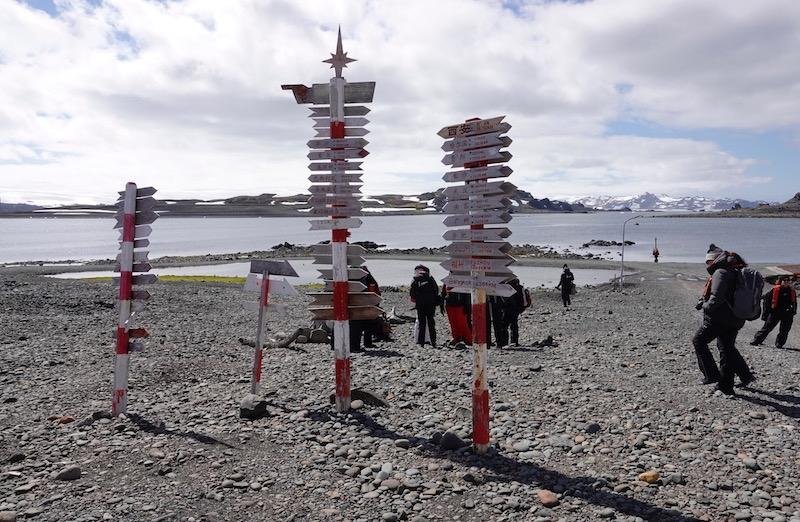
News (123)
Originally, we were supposed to go further south to Verdansky Station, Prospect Point and Petermann Island but once again the sea ice and the weather are against us and it turns out there will be no landings for several days. This can be hard for people to understand in today’s world where travel is seen as relatively straightforward and we can cross the globe in 24 hours by jet. We are used to getting to places on time and can get annoyed if we are delayed for a few hours or redirected.
In Antarctica travel is still very much determined by the elements. Sea ice is still a real danger to shipping, just as it was for early explorers and sealers and whalers. Most ships have ice strengthened hulls but they are still only able to break through relatively small depths of sea ice, and ice can still damage their hulls. Ships can still get stuck in ice, like Shackleton’s Endurance which got stuck, squeezed and eventually sank in 1915. Even today rescue operations are time consuming, expensive and can divert icebreakers from their primary tasks of resupplying stations or doing science. Plus no captain wants to get stuck and have to call mayday.
While we still can’t control the weather, the main advantage we have today is that modern communication and satellites mean that we know what the sea ice looks like before we get there. We also have much better ideas of the weather systems that are on the way. And the ship’s captain can communicate with other ships in the area to find out what conditions are like at sea level. This means that the captain and voyage leader are constantly planning ahead and revising and adapting our voyage plan to ensure we get the best experience and don’t get stuck. As an Antarctic scientist I am well aware of the work that goes in behind the scenes to get expeditioners to stations and back. Because our plans are changing we ask Monica to explain to everyone what has been happening behind the scenes and why we can’t go ashore for a few days. She also gives us a lecture on ice.
Instead of going to Verdansky, we moor up and have a zodiac cruise where we observe sleeping humpback whales, seals and penguins. There are some spectacular glaciers and we see an avalanche as a huge chunk of ice falls off the face of the cliffs. We can also see how fast some of these glaciers are retreating with climate change.
The next day the ship takes up to the edge of the ice (Flanders Bay) and we see the spectacular variations in sea ice forms including the thin films of grease ice and the wonderful fluffy disks which are called pancake ice. We also see some massive icebergs (kilometers long) that have calved off the retreating glaciers.
Just last week, a ship searching for the wreck of Endurancewas forced to abandon its search because of heavy sea ice. They also lost their autonomous underwater vehicle because of inclement weather and bad sea ice conditions.
We were booked to go ashore at Palmer Station, the American base on Anvers Island, on the 9thJan, but the brashy, sea ice had blown in around the station making it too risky for the Ushuaia staff to take zodiacs in. So about 10 expeditioners from Palmer come aboard the ship to tell us about the science that is happening on the base.
I am really happy to see that one of my colleagues from the US Dr Zicheng Yu(Zic) from Lehigh University, is one of those researchers. Like my group, Zic is using stable isotopes of carbon, and also oxygen, to understand how plant growth is affected by climate change in Antarctica. Specifically, Zic is a paleoecologist and works with peat mosses. These are mosses that have been growing for thousands of years in wet, boggy sites and the older mosses become compressed and peaty as the plants above press down. The wetness helps to preserve the moss which means it can contain climate records that go back for thousands of years. Zic has sampled such mosses from Patagonia and is interested in how far South the peat mosses extend. The Antarctic mosses we work with are younger, hundreds, rather than thousands of years old, but we are working with individual plants, not peat. In peat there can be layers and layers of different mosses and even grasses and other plants as you delve down into the core. Our individual plants are only a few centimeters tall whereas peat cores can be meters deep. It’s all a matter of scale. In East Antarctica the mosses grow a few millimeters each year, whereas on the peninsula they might grow a whole centimeter in a year!
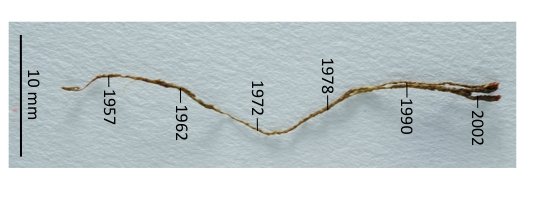 Zic and I last met at the SCAR Open Science meeting in Davos in June, when Dr Melinda Waterman and I spoke at the same session as him. Zic tells everyone on the ship about the work that we are doing on Antarctic moss which is great visibility for me! He also has a University research position in China and so I introduce him to the Chinese HB3 team.
Zic and I last met at the SCAR Open Science meeting in Davos in June, when Dr Melinda Waterman and I spoke at the same session as him. Zic tells everyone on the ship about the work that we are doing on Antarctic moss which is great visibility for me! He also has a University research position in China and so I introduce him to the Chinese HB3 team.
After the formal session we go onto the front deck for photographs and also get to talk to the Palmer staff. It’s really nice to meet a range of expeditioners including scientists and the staff who keep the station running and support the researchers on the base.
All the expeditioners at Palmer were affected by the US Government Shutdown. Staff employed by the government were working for no pay and having trouble ordering supplies for the station for the coming season. Some of the scientists cannot get to their sites to do research, because the public servants in the US who prepare the permits are on furlough and can’t process the permits. This is such a waste of everyone’s time and is ultimately a waste of the NSF grant money. I am hoping that some of this has resolved since we got back and Zic and his colleagues got their work done. Lets hope the rest of the season is productive for them all.
Palmer is part of the Long-Term Ecological Research (LTER) Network with a study area extending North and South of Palmer from the coast to several hundred kilometers to the west side of the Antarctic Peninsula.
Homeward Bound 6 - Glacier zodiac cruise in Anvord Bay, near Neko Harbour,
Written by Sharon RobinsonWe were supposed to go ashore at Neko Harbour but it was ice bound. The wind has blown the sea ice close to shore and so we can’t get ashore in the zodiacs. It’s too dangerous to risk puncturing them.
So, we have a glorious glacier cruise and see more spectacular ice formations both cascading off the continent and in the icebergs and sea ice.
We collect clear, black ice for the bar and see glacial deposits where rocks and silt are layered into the icebergs.
We also find some moss on a Point near Neko Harbour. I am hoping it’s a new description and we can go back to study it! Although it’s on a pretty sheer rock face so it would be tough to collect. I think we would need a drone to collect samples for us.
We were on an iceberg cruise on the zodiac and our guide was Juan, a fellow plant enthusiast so when I spotted green through my binoculars and asked if it was moss or algae, he was happy to get closer to check it out. It was on a huge volcanic plug with full length dykes running down the steep cliffs.
On one side was a stream of moss cascading down terraced steps in the rock face. Very exciting. Just above the moss we spotted 2 Antarctic tern chicks which were probably helping to fertilise the moss stream.
Then of course we were miles from the ship and the weather closed in so it was foggy on the way back and for the first time we had to navigate back to the ship on GPS. It was cold and felt properly Antarctic in the zodiac and we had to keep an eye out for bergy bits of sea ice. Very exciting for us all because it felt a bit intrepid, but I didn’t want to get a reputation for being the last one back on the zodiacs and holding up the ship. Don’t want to set a bad example!
Each day the participants on the voyage spend 4-5 hours on the leadership program and we attempt to have a landing or a zodiac cruise if landings are not possible. I am leading the on board science program with Dr Katherine Duncan from the University of Strathclyde. Kate was a participant on the second voyage (HB2) back in March. We hadn’t met before this voyage but had talked on whats app and zoom calls whilst preparing the program along with the science faculty founders, Dr Justine Shaw (University of Queensland) and Dr Mary-Anne Lea (University of Tasmania). Kate is a wealth of knowledge about the HB program, the ship and what we need to bring with us. Luckily, both she and Dr Sophie Adams (our wellbeing guru and also a HB2 alumna) brought real coffee, an important component for wellbeing on the ship as elsewhere!
Having only met on the 28thDecember, Kate and I are now sharing a cabin, running a science theme together, enjoying our new-found friendship and planning future science grant applications. We also get to be on one of the first zodiacs ashore in order to supervise the landings and are often last back as we round up the stragglers who just want an extra minute ashore and, that last photograph or video.
The next landing is on Cuverville Island (7thJan) where we find Gentoo penguins nesting and skuas patrolling.
Cuverville Island is very snowy and the chicks were tiny, but at one end it has the most amazing wall of moss, a whole cliff face, green and grey against the white-grey sky. I would love to visit again and take moss samples for dating, to see how old these moss forests are.
We watched penguins rolling eggs or feeding chicks as well as well as mating. Presumably many of these Gentoo penguins have also had aborted attempts at rearing their first clutch of chicks this season.
I take the opportunity to segue from penguin sex to moss sex to the amusement of the nearby participants and Fern Hames (Arthur Rylah Institute)our on-board Sci-Comms facilitator.
On the way back to the ship we have a spectacular iceberg cruise, full of amazing blue, turquoise and white shapes against the grey of the sea.
Antarctic moss biflavones show high antioxidant and ultraviolet screening activity
Written by Sharon RobinsonCeratodon purpureus is a cosmopolitan moss that survives some of the harshest places on Earth: from frozen Antarctica to hot South Australian deserts. In this study we isolated nine compounds from Australian and Antarctic C. purpureus and considered how they might help this species to survive under such extreme conditions.
The Ushuaia then started sailing down the western side of the peninsula and the following day (6th Jan) we went ashore at Hydruga Rocks where we saw Chinstrap penguins nesting. There was lots of snow as we moved southwards down the peninsula and this is not good news for the nesting birds, since most of them want rocky surfaces to nest on. Frequent falls of snow during the summer mean that the penguins have trouble finding nesting sites and pebbles to build their nests and Monica thinks that many have already had failed attempts at nesting this season. Many are still sitting on eggs, possibly their second attempts this year and the chicks we see are very small.
There are also weddell and crabeater seals on the island as well as giant petrels, Antarctic sheathbills and cormorants. The kelp gulls have assembled a midden of limpit shells on the crest of the island near their nest sites.
The soft snow also makes for interesting travelling for us. Many of the participants are new to walking in snow and it proves especially challenging when we attempt to assemble everyone into a heart shape for some Homeward Bound publicity shots. Penguins even come up to see what we are are doing.
That night we moor in the peaceful and stunningly beautiful Wilhelmina Bay and enjoy the frolicking of lots of humpback whales.
Saturday (5thJan) we are back on King George Island, at the Argentinian Carlini Base. Carlini is the only station in Potter Cove and is named after a scientist Alejandro Ricardo Carlini. The station sits beneath the impressive Tres Hermanos mountain and the nearby glaciers are retreating rapidly exposing new rocky areas.
The weather is overcast, cloudy with wet snow. Young elephant seals haul out amongst the chunks of glacial ice that are washed up along the beach.
We tour the Science labs, the Dive sheds and also are given refreshments in the station mess. There is a compression chamber in the Dive facility and a technician to operate it in case the divers run into problems.
The scientists on station came from many countries and tell us about the current science research programs that are running on and around the station including a lot of marine biology and hydrology. It is great to see another base in action and to hear first-hand from the scientists about their research. It is also wonderful that so many people on station are prepared to give up their Saturday to entertain visitors.
The projects include remediation projects aimed at understanding how plants and microbes can clean up contaminated soil around Antarctic stations. Many sites in Antarctica are contaminated with oil and other chemicals as a result of historic waste practices and some of my students have investigated how tolerant Antarctic mosses and alga are to oil and if Macquarie Island plants can help promote soil clean ups.
I was particularly excited to see so much moss and lichen around Carlini, as well as the two vascular plants that grow on the peninsula region of Antarctica, the grass Deschampsia antarctica and the pearlwort, Colobanthus quitensis. The lichens and mosses have even started to colonise the whale bones that remain from historic whaling in the region.
After Great Wall Station we get back on the ship and head off through the Antarctic Sound on the Eastern side of the peninsula. Lots of spectacular tabular icebergs and humpback whales breaching, showing off their tails, and flipper slapping make for a glorious evening’s sailing.
Paulet Island is our next landing spot (4thJan). This island is home to a massive Adelie penguin rookery (100,000 breeding pairs) as well as skuas, kelp gulls, Antarctic sheathbills and cormorants.
The Adelie’s have fluffy brown chicks and so the challenge was to walk along the beach keeping enough distance from the penguins and other nesting birds to reduce our impact. While the younger Adelie penguins were quite curious about us, the nesting birds are understandably wary of visitors especially with so many predatory skuas on the hunt for food. Paulet island also has the remains of a hut built last century by shipwrecked sailors from the Nordenskiöld ship the Antarctic. Today the hut walls are high-rise nesting sites for Adelie penguins.
There is also a massive lake in the middle of the island which is green with algal blooms from all the penguin guano. Even in the cold, the smell from such a large colony is pretty overwhelming.
Despite there being so many Adelie penguins on Paulet, this species is one of the losers from climate change. Adelie penguins are reliant on sea ice and cooler water to provide food and so are losing out to the more generalist feeders, chinstrap and Gentoo penguins, which are expanding southwards especially on the western side of the Antarctic peninsula.
The Ushuaia crew are Argentinian and Chilean. Our female voyage leader Monica Schillat, is an historian and has many tales to tell of her years of working on Antarctic vessels. Kata, one of the expedition guides, has just finished her PhD researching orcas which means we have lots of expertise to draw on. Leandro and Juan like plants too so I am in good company. Because the weather is so calm we get to take many iceberg cruises and see lots of humpback whales and orcas. One night I am sure I can hear the humpbacks calling and in the zodiac boats we get close enough to smell their fish-oily breath. We often see weddell and crabeater seals hauled out on ice flows or swimming along beaches.
Sharon has just returned from 19 days aboard the MV Ushuaiaas part of the Homeward Bound HB3 voyage. Homeward Bound is a ground-breaking leadership initiative, set against the backdrop of Antarctica, which aims to heighten the influence and impact of women in making decisions that shape our planet.
I was invited to join the Homeward Bound Leadership Faculty for the third voyage (HB3) which departed Ushuaia in Argentina on 31st Dec 2018. My role was to deliver the On-Board Science Stream content with Dr Katherine Duncan (University of Strathclyde). In 2019 we were extremely lucky to have the inspiring and stubbornly optimistic Christiana Figueras join the Leadership Faculty. This is my blog.
Days 1-6
We left on New Year’s Eve 2018, after two days of travelling and then three days of on shore program delivered in Ushuaia. By the time we found our cabins and unpacked, securing all our belongings to ensure they survived the Drake Passage, we were ready for a good rest. So many of us spent a lot of the Drake crossing catching up on sleep.
We arrived in the South Shetland islands on the 3rd Jan 2019.
Our first visit ashore was to King George Island which is home to many Antarctic stations. I have visited this island twice before with colleagues, Dr Angelica Casanova-Katny (University of Temuco) and Professor Gustavo Zuniga (USACH), staying at the Chilean Summer Scientific Station, Escudero. I am excited to see Ardley Island from the ship as we sail by. This Antarctic Specially Protected Area, has some of the best lichens I have ever seen, but I am surprised to see there is very little snow on the island. However, this is good news for Dr Melinda Waterman who will be arriving at Escudero in the next few days. Less snow means it will be easier for her to make the measurements of moss microclimate that we need.
Meanwhile, the HB3 team visit the Chinese Great Wall Station where were saw the museum which shows what life was like for Antarctic expeditioners in the 1980s and walked around the station. While visits to stations by tourist ships are limited, interstation visits for researchers are quite common. In 2015, whilst at Escudero, I was lucky enough to be invited to Sunday afternoon tea at Great Wall Station and we saw the new Science Laboratory and station library.
More unusually, in 2013, Angelica and I attended the Metallica concert at Carlini Base. Not the sort of thing you expect to be invited to whilst researching mosses in Antarctica! King George Island was the furthest south I had been on this side of Antarctica so all the other locations were new experiences for me.
The lush moss beds that grow near East Antarctica’s coast are among the only plants that can withstand life on the frozen continent. But our new research shows that these slow-growing plants are changing at a far faster rate than anticipated.
Read more in the Conversation
Plus here is a link to our latest youtube video
Sharon Robinson, Melinda Waterman & Andrew Netherwood (2017) East Antarctic mosses reveal a windier, drier climate
The paper is available here if you want to read it. This email address is being protected from spambots. You need JavaScript enabled to view it. if you want a copy.
Robinson SA, King D, Bramley-Alves J, Waterman MJ, Ashcroft MB, Wasley J,Turnbull JD,Miller RE,Ryan-Colton E, Benny T, Mullany K, Clarke, LJ, Barry, L, HuaQ. (2018) Rapid change in East Antarctic terrestrial vegetation in response to regional drying. Nature Climate Change8, 879-884, DOI: 10.1038/s41558-018-0280-0

